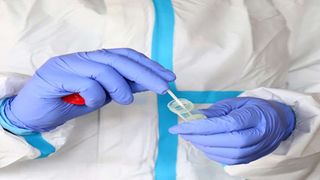
A health worker collects a sample for Covid-19 testing from a resident of Kibera, Nairobi, on October 18, 2020.
| File| Nation Media GroupNews
Premium
Low Covid cases leave many scratching their heads
What you need to know:
- By Thursday, 99,444 people had tested positive with 1,736 deaths, according to the Ministry of Health.
- According to ministry data, there have been reduced hospitalisations and severe cases of Covid-19 for the past several weeks.
Cases of Covid-19 remain low, three weeks after schools opened, contrary to the expectations of many.
The positivity rate has gone done from a high of 20 per cent several weeks ago to the current average of 2.8 per cent in the past seven days.
The difference between the period from January 14 to January 20, 2021 and November 14 to November 20, 2020 is like day and night.
While November was dubbed the “darkest month”, January could be described as the best-looking month in the history of the pandemic in Kenya so far.
Out of 47,968 samples tested during the select week in November, 7,000 returned positive while in January only 889 infections have been reported in the same period from 32,529 samples tested. This is a difference of 6,111 people infected and 15,439 samples tested.
By yesterday, 99,444 people had tested positive with 1,736 deaths, according to the Ministry of Health.
Unlike in the western world where spikes in infection were reported immediately after schools and economies were reopened, the case is different for Kenya. From the start of the year, cases have also remained low despite the Christmas and New Year festivities, open schools and an open economy.
With more than 16 million learners in school in the past three weeks, and more than 60,000 public transport matatus and buses operating on Kenyan roads every day for the past several months, the situation was expected to look bad by now.
According to ministry data, there have been reduced hospitalisations and severe cases of Covid-19 for the past several weeks. As of Wednesday, there were 686 patients in various hospitals in the country, 30 in the Intensive Care Unit and 11 on supplementary oxygen.
A source at the Aga-Khan University Hospital in Nairobi said that, unlike two months ago when severe cases made it hard to get a free ICU bed, the unit is not busy currently.
The MP Shah Hospital, which had set aside three floors to accommodate Covid-19 patients, is also not as busy as it was in November.
“Right now we have ICU beds which are not occupied, unlike at the height of the pandemic when you could not get any,” said Ms Ann Gacheru, a customer service representative at the hospital.
Data from the Lancet laboratories also show that tests are returning fewer positive results compared to last year, although the cases are going up, said Dr Ahmed Kalebi, the CEO of Lancet Kenya.
“They have steadily gone up over the last three days though not a dramatic spike as yet, but worryingly so. Most of the cases are clustered in among some few family members and friends, rather than being an indication of random community spread,”Dr Kalebi said.
The low number of cases is being attributed to less testing, reduced community transmission, and fewer people, especially those who are asymptomatic, seeking testing and treatment.
Have we escaped the worst?
So, has Kenya escaped the pandemic? Experts do not think so, with the latest scientific projections from the Kenya Medical Research Institute (Kemri) indicating that the most plausible scenario is the rate of Covid-19 case and death incidence peaking in mid-March.
“I am holding my breath. We all should,” said Dr Yubrine Moraa Gachemba, a consultant internal medicine physician at the Nairobi Hospital. What seems to be a ‘big escape’ could actually be the takeoff of a new spike, she added.
“Many children do not show signs of Covid-19. It takes 14 days for the virus to incubate. Maybe this is the time the cases are converting,” said Dr Gachemba.






